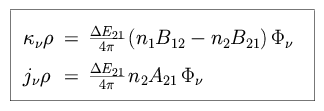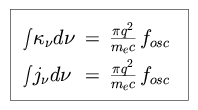Einstein Coefficients
There are three Einstein coefficients, B12, B21, and
A21, which are used to calculate the probability per unit time for
emission or absorption of a photon from an energy level within an atom.
Spontaneous emission: A21 is the probability per
unit time for spontaneous emission of a photon, moving an electron from the
upper level to the lower level. It may be calculated from first principles,
using quantum mechanics.
Absorption: B12 × J is the probability per unit time
for absorption of a photon, moving an electron from the lower level 1 to the
upper level 2.
is the probability per unit time
for absorption of a photon, moving an electron from the lower level 1 to the
upper level 2.
Stimulated emission: B21 × J is the probability per unit time
for stimulated emission, moving an electron from the upper level to the lower
level.
is the probability per unit time
for stimulated emission, moving an electron from the upper level to the lower
level.
 |
| [NMSU, N. Vogt] |
Because the line profile 
 has a finite width, the mean
intensity J
has a finite width, the mean
intensity J should be
calculated for this purpose by integrating over the width of the line profile
in frequency space:
should be
calculated for this purpose by integrating over the width of the line profile
in frequency space:
For atoms in a state of thermodynamic equilibrium, there are three
conditions which are met.
- The radiation field can be expressed as
- There is an equilibrium condition between the rate of absorption and
the rate of emission. We define ni as the number density
of electrons in energy state i, and then require that
- The number density of electrons in energy state i is determined
by the temperature of the gas. Defining gi as the
statistical weight (i.e. the degeneracy) of state i,
The ratio of the electron density between levels is then given by
We observe that at low temperatures, most electrons are found in the ground
state, while at high temperatures the higher energy levels will be populated.
The mass absorption and emission
coefficients, in units of erg/gm/s/str/Hz, become
Furthermore, defining the oscillator strength of the transition,
 is the probability per unit time
for absorption of a photon, moving an electron from the lower level 1 to the
upper level 2.
is the probability per unit time
for absorption of a photon, moving an electron from the lower level 1 to the
upper level 2.
 is the probability per unit time
for stimulated emission, moving an electron from the upper level to the lower
level.
is the probability per unit time
for stimulated emission, moving an electron from the upper level to the lower
level.








